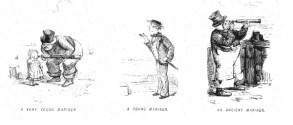Product Lifecycle
When users interact with your product or service, their default has gone through a series of steps called the life cycle use. Using life cycle is like a map of the user’s experience with your design.
Like other life cycle, life cycle using a beginning, middle, and end, each time period is characterized by behavior and different goals. And the action is very different in each stage of the life cycle.
Here is an overview of the stages:
First exposure: When people know the product / service. This is when people discover and interested in what you have designed.
This is where their perceptions are formed … so they understand all of what you can design? They know how to use it? They feel the products / services you how great?
First use: This is perhaps the most important time in the life cycle of your design. It is the first impression when customers use your actual design and now is the time users should seriously consider the long-term use?
Unfortunately, this period is often overlooked in the design process because it happens quickly …
Continuous use: Regular use of products / services.
Passionate use: Although it is the aim of all the designers, their design is the continuous use, this stage is rarely achieved. But when you achieve, you will be in a state in which they use with high frequency / immersed in your design, and often share the passion with others.
This is the principle of natural growth to happen … and then your design really took off.
Closing (or simply Death): When people stop using the product / service. This can happen at any time throughout the life cycle.
The reason is that your design may too hard to use dụng.Có perhaps it does not have an important feature for someone to pay attention. Maybe someone has found a better way to do this.
No matter the reason, UX design gained insight by regularly improved through the experiments or experiment groups, and the most important is the experience of the life cycle ending soon.
When we started shaking hands at forming a design lifetime use, we began to see each stage has different design challenges like.
The problem occurs with the first contact will not happen with the later stages. A complex problem of regular users never happen to someone just starting out.
In this way, determine the user is in the process of life is very important. Important as we need to “know your users,” we need to know what they are doing, they are in their life cycle point of use.
YOU ARE NOT YOUR PRODUCT USER
Philosopher Socrates said: “Know yourself.”
I say: “Know your customer”
And we have to guess what? Customers think the same as what you are doing. You know your product inside and out. You know it since it’s just a sketch on a napkin. You used to use it all the time, and to apply these ideas, your interests in all aspects of the product.
However, the problem here is that there are plenty of users visiting the site or using your product for the first time. Many of them have one goal in mind and they use your services because they believe it will help them achieve that goal.
And some, carefully explore around, with psychological unlikely to use your products, due to their previous experiences make them unhappy.
“It’s important to know what is necessary to get customers to use the product” – Donald Norman.
This is a necessity as it is a model that you do not share, this is a necessity because it forces you to objectively provide what users need, not based on my opinion.
It is also essential, because it can save the basic rate of errors when you assumed the habit of the user and it will give you an insight to create a product that will give users the interest.
It is lucky to answer this, we have enough technical measures to implement and obtain a better understanding of users and their habits. The combination of the following techniques will help you get started:
Interview users: Create polls and talk oriented to existing users or potential users will help you to better understand their preferences and behavior.
Contextual Studies: Combining observations direct users to an interview takes place while they are using the product and find out the needs and habits related.
Survey – clear set of questions distributed to a wide audience to collect the results can help to confirm existing data and analysis.
Using card sorting (Card sorting): A group of tasks to individuals or small groups are used to set up common tasks and review process to remove false or mistaken idea.
Use Test: This process is done by a series of specific tests on a website or product to reveal usability issues and identify potential solutions to address them.
In short, take the time to understand the user It will reduce the risk of creating an unfavorable experience and provide you with an opportunity to turn users into your biggest supporters.


